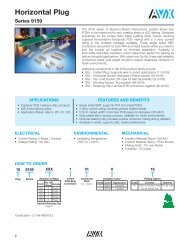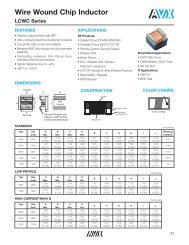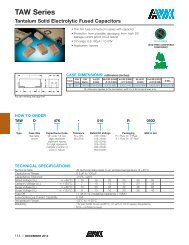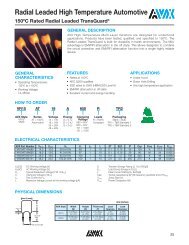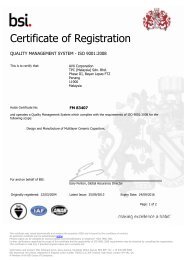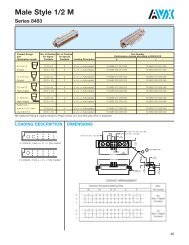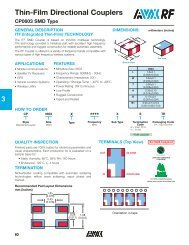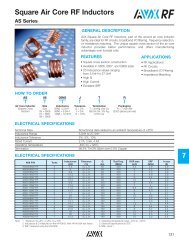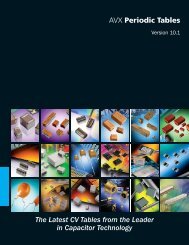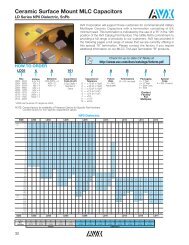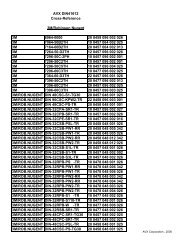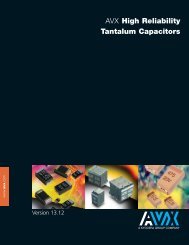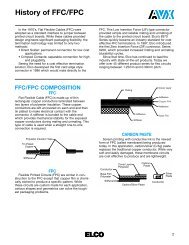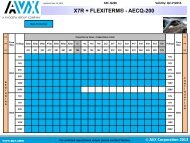Increasing Reliability of SMD Tantalum Capacitors - AVX
Increasing Reliability of SMD Tantalum Capacitors - AVX
Increasing Reliability of SMD Tantalum Capacitors - AVX
You also want an ePaper? Increase the reach of your titles
YUMPU automatically turns print PDFs into web optimized ePapers that Google loves.
TECHNICAL<br />
INFORMATION<br />
INCREASING RELIABILITY<br />
OF <strong>SMD</strong> TANTALUM CAPACITORS<br />
IN LOW IMPEDANCE APPLICATIONS<br />
by David Mattingly<br />
Applications Engineer<br />
Myrtle Beach, SC<br />
Abstract:<br />
High dv/dt conditions in<br />
low impedance circuits using<br />
surface mount tantalum<br />
capacitors is discussed.<br />
Circuit designs utilizing<br />
low R (DS)ON MOSFETs<br />
for preventing these conditions<br />
are presented in detail.
INCREASING RELIABILITY OF <strong>SMD</strong> TANTALUM<br />
CAPACITORS IN LOW IMPEDANCE APPLICATIONS<br />
by David Mattingly<br />
Applications Engineer<br />
Myrtle Beach, SC<br />
1.0 Introduction<br />
<strong>Reliability</strong> over time, temperature stability over the<br />
range -55 to +125 degrees C, high volumetric efficiency,<br />
and low ESR has lead to the solid tantalum capacitor<br />
being the dielectric <strong>of</strong> choice for decoupling, bypass and<br />
filtering applications in the (10-330) micr<strong>of</strong>arad range.<br />
Many applications for the higher capacitance values will<br />
have low circuit impedances and will require the designer<br />
to have an understanding on the strengths and weakness<br />
<strong>of</strong> tantalum capacitor technology. In low impedance<br />
applications, current in-rush is always a concern and has<br />
typically been controlled by the inclusion <strong>of</strong> external<br />
series resistance in the circuit to promote self healing. 1,4<br />
A high current in-rush application is defined as one<br />
where over one ampere <strong>of</strong> charging current is available<br />
to the capacitor. 2<br />
The recommended series resistance for solid tantalum<br />
capacitors in low impedance applications in the late<br />
fifties and sixties was three ohms per working volt to<br />
ensure standard operational component level reliability.<br />
The three ohms per working volt was empirically determined<br />
as the amount <strong>of</strong> resistance required to prevent<br />
breakdown caused by “scintillation” (momentary dielectric<br />
breakdown). 3,4 This additional amount <strong>of</strong> series<br />
resistance was not critical due to the low frequency<br />
applications where tantalums were used. Filtering at<br />
120 Hz for a 100µf capacitor yields a reactance <strong>of</strong> about<br />
13 ohms. A few ohms <strong>of</strong> series resistance in this application<br />
was not critical. 3 Typical switching frequencies in<br />
DC-DC converter applications today can range from a<br />
few kilohertz to the megahertz range. The same capacitor<br />
used at 100 KHz has a capacitive reactance <strong>of</strong><br />
approximately 15 mOhms. The ESR <strong>of</strong> the capacitor is a<br />
larger contribution to impedance than the capacitive<br />
reactance. Addition <strong>of</strong> a few ohms <strong>of</strong> resistance is not<br />
possible if the capacitor is to be application effective.<br />
Here the additional resistance would reflect a measurable<br />
contribution to the loss in efficiency <strong>of</strong> the circuit.<br />
By the seventies and eighties these recommendations<br />
for steady state applications had reduced to one ohm<br />
per working volt. Today, <strong>AVX</strong> references one hundred<br />
milliohms per working volt for standard steady state<br />
reliability on all <strong>of</strong> its tantalum product lines. These<br />
changes are a direct result <strong>of</strong> advances in manufacturing<br />
processes and increases in the purity <strong>of</strong> capacitor grade<br />
tantalum powders. However, these recommendations<br />
are for steady state conditions within circuits and do not<br />
directly address dynamic conditions (i.e. voltage and<br />
current transients).<br />
With the advent <strong>of</strong> surface mount technology and the<br />
associated closer interconnection distances, the actual<br />
series resistance available in applications has reduced,<br />
making transients an even more important consideration.<br />
When tantalum capacitors are used in such low<br />
series impedance applications they are subject to large<br />
current in-rushes, especially if the source supply is <strong>of</strong><br />
low impedance. During initial testing <strong>of</strong> assemblies, this<br />
environment can produce a low, but measurable PPM<br />
(Parts Per Million) fallout <strong>of</strong> early life failures under certain<br />
circuit conditions.<br />
In the following sections, this failure mode and the<br />
conditions under which it can occur are defined. The<br />
component level solutions being employed by manufacturers<br />
are also reviewed and alternative design level<br />
solutions are introduced and discussed.<br />
2.0 Component Level Solutions<br />
The construction and manufacture <strong>of</strong> tantalum capacitors<br />
is well defined within several industry papers referenced<br />
in the bibliography 1, 3, 5, 12 . The construction <strong>of</strong><br />
the tantalum capacitor element is such that the tantalum<br />
pentoxide dielectric is operated under a high degree<br />
<strong>of</strong> electrical stress.<br />
This can best be understood with reference to the<br />
construction <strong>of</strong> the part. A typical 22 micr<strong>of</strong>arad device<br />
capacitor rated at 20 volts has a dielectric layer thickness<br />
<strong>of</strong> less than 1 micron and a dielectric area <strong>of</strong> 150<br />
square centimeters. This gives rise to a field strength<br />
(steady state) <strong>of</strong> 147 kilovolts per millimeter. 6 By preconditioning<br />
the capacitor to a low impedance current<br />
surge while maintaining maximum dielectric stress, a<br />
certain degree <strong>of</strong> control over later surge susceptibility<br />
can be achieved. Most manufacturers have now incorporated<br />
current surge testing to accelerate any infant<br />
mortality or latent defect failures in their product.<br />
Surge test is an important assessment <strong>of</strong> the dielectric<br />
quality.<br />
Typical current surge testing on capacitors is performed<br />
by charging a large bank <strong>of</strong> electrolytics to the<br />
working voltage <strong>of</strong> the capacitor, and then discharging<br />
the bank through a lowR (DS)ON<br />
FET to the device under<br />
test. The FET prevents contact bounce commonly seen<br />
in relay or mercury switch operations. If the component<br />
were to be exposed to contact bounce the average RMS<br />
<strong>of</strong> the current would be decreased by the open contact<br />
periods. The most important aspect <strong>of</strong> eliminating contact<br />
bounce is to ensure that the maximum peak current<br />
is delivered to the device under test. The amount <strong>of</strong> current<br />
the capacitor will see depends on the impedance <strong>of</strong><br />
the test setup. A total impedance <strong>of</strong> one to two ohms is<br />
common. This impedance comprises the cable resistance,<br />
contact resistance, interconnections, and inductive reac-
tance <strong>of</strong> the supply cable. In order to verify a part<br />
receives the correct amount <strong>of</strong> surge current , a current<br />
sense resistor and monitoring circuitry is typically<br />
incorporated into the test setup. 5<br />
2.1 Component Choice and Surge Resistance<br />
One <strong>of</strong> the factors affecting the peak current developed<br />
in the capacitor is the intrinsic equivalent series<br />
resistance (ESR).When considering the peak current<br />
delivered in a given application or test, this must be<br />
taken into consideration.<br />
Assume a 22 micr<strong>of</strong>arad component rated at 25 volts<br />
is subjected to a surge test similar to the one previously<br />
described. The <strong>AVX</strong> TPS low ESR product line has a<br />
maximum ESR <strong>of</strong> 0.200 ohms at 25 degrees C. The standard<br />
<strong>AVX</strong> TAJ component has a maximum ESR <strong>of</strong><br />
0.900 ohms at 25 degrees C. Therefore the following are<br />
received by each component using a 1 ohm impedance<br />
for the test setup resistances.<br />
TPS<br />
I Peak<br />
= E / Z<br />
We can generalize and say that<br />
Z = R for this example.<br />
I Peak<br />
= 25 volts / (ESR) + R Cable<br />
I Peak<br />
= 25 volts / 1.2 ohms<br />
I Peak<br />
= 20.83 amps<br />
Standard TAJ<br />
I Peak<br />
= E / Z<br />
I Peak<br />
= 25 volts / 1.9 ohms<br />
I Peak<br />
= 13.15 amps<br />
The inductive component for the leadframe <strong>of</strong> the<br />
capacitor is approximately 3 nanohenries and can be<br />
neglected for the purpose <strong>of</strong> this example. The time<br />
constant for the surge will be the product <strong>of</strong> the capacitance<br />
under test and the impedance <strong>of</strong> the test setup.<br />
To quantify, we are typically looking at 10µ to 330µ seconds<br />
depending on capacitor value. This brings up<br />
another dilemma that the test engineer faces when<br />
implementing current surge testing. The smaller the<br />
capacitor the shorter the time constant. The shorter the<br />
time constant the shorter the voltage rise time has to be<br />
in order to deliver the maximum surge possible.<br />
2.2 Surge Considerations in Specific<br />
Applications<br />
As can be seen from the above illustration, there is a<br />
significant difference in the exposure level between<br />
standard and low ESR components when subjected to<br />
current stress screening. The magnitude <strong>of</strong> the surge<br />
each component receives is inversely related to the component’s<br />
ESR. <strong>Capacitors</strong> should be surge tested individually<br />
for this reason. If the components were placed<br />
in parallel for surge testing, the variation in ESR<br />
between the individual capacitors and the amount <strong>of</strong><br />
trace inductance/resistance between each will distribute<br />
the current unequally. By surge testing individual parts,<br />
this variation is reduced which gives a greater level <strong>of</strong><br />
consistency in the maximum surge received by each part.<br />
When these components are placed into a circuit with<br />
no series resistance and the source is <strong>of</strong> low internal<br />
impedance, the only limiting factors affecting the<br />
amount <strong>of</strong> current available are the interconnection<br />
resistances, the internal impedance <strong>of</strong> the source (or linear<br />
regulator, switcher, etc.), the trace resistances, and<br />
the capacitor ESR. A worst case example <strong>of</strong> what the<br />
same capacitor could see in the low impedance input circuit<br />
<strong>of</strong> a notebook computer is as follows:<br />
Capacitor Resistance<br />
Nickel-Cadium Battery (D1)<br />
Board Trace resistance<br />
Battery Contact Resistance<br />
Total<br />
200 mohms<br />
35 mohms<br />
15.0 mohms<br />
10.0 mohms<br />
260.0 mohms<br />
A fully charged battery pack <strong>of</strong> 10 vented sintered<br />
plate Nickel-Cadium batteries (standard D cell) would<br />
have a open circuit voltage <strong>of</strong> 12.5 volts when fully<br />
charged. 7 Nominal operating will be 12.0 volts. Total<br />
internal resistance will be approximately 35 milliohms<br />
(3.5 x 10). The variation in series resistance among different<br />
Nickel-Cadium configurations is large and contributable<br />
to differences in cell design and packaging.<br />
Using the approximate figure <strong>of</strong> 300 milliohms for all<br />
resistances would result in possible current in rush <strong>of</strong><br />
40.0 amps at initial turn on.<br />
I MAX<br />
= 12.0 volts / 300 mohms<br />
I MAX<br />
= 40.0 amps<br />
The only limiting factor is the 300 milliohms resistance<br />
<strong>of</strong> which the capacitor ESR is the main contribution.<br />
This means that the initial power dissipation (energy<br />
loss) <strong>of</strong> the circuit for the current in-rush condition<br />
will be predominantly from the capacitor ESR. This<br />
magnitude <strong>of</strong> current in-rush far exceeds any current inrush<br />
test performed in mass production facilities today<br />
and reinforces the need for implementing current inrush<br />
precautions. A list <strong>of</strong> possible operational conditions<br />
where this scenario could occur is provided in<br />
Section 2.2.1.<br />
As a general note, adding multiple capacitor components<br />
in parallel will assist in operational ripple current<br />
sharing provided that track resistance and inductance is<br />
minimized. But adding multiple parallel capacitors will<br />
also decrease the effective ESR <strong>of</strong> the capacitor bank<br />
allowing higher peak currents from the supply source.<br />
The amount <strong>of</strong> current each capacitor in the bank will<br />
see depends on its individual ESR.<br />
The use <strong>of</strong> Low ESR <strong>Capacitors</strong> increases the amount<br />
<strong>of</strong> ripple current the capacitor can handle for the same<br />
case size power rating and will also provide lower ripple<br />
voltage output than standard components. But the
intrinsic lower ESR also allows for higher current inrush<br />
conditions when subjected under the same conditions as<br />
standard components.<br />
2.2.1 DC-DC Converter Input Filtering<br />
The primary failure location <strong>of</strong> tantalum capacitors<br />
when used in a power supply application is the input side<br />
<strong>of</strong> the regulator or converter. This is primarily due to<br />
the capacitors exposure to an uncontrolled energy supply<br />
<strong>of</strong> low impedance. The dv/dt the output capacitors<br />
will see is typically a function <strong>of</strong> the “s<strong>of</strong>t start” <strong>of</strong> many<br />
converters. It is common to take several cycles for a<br />
switch mode power supply to ramp up to the intended<br />
output voltage. The inductor in series with the output<br />
capacitors in many topologies also ensures that current<br />
in-rush is limited to the output capacitors.<br />
To better understand how input capacitor failures<br />
occur, we need to evaluate the response <strong>of</strong> a step function<br />
on the input circuit. A capacitor subjected to a high dv/dt<br />
can have its dielectric damaged. Once the dielectric is<br />
damaged, normal operating conditions (high ripple at elevated<br />
temperatures) will allow rapid breakdown <strong>of</strong> the<br />
capacitor. The ability <strong>of</strong> the capacitor to self heal momentary<br />
breakdown <strong>of</strong> the dielectric is nonexistent in low<br />
impedance circuits. 2 We can use a simple series/parallel<br />
circuit to demonstrate the minimum allowable rise/fall<br />
time for prevention <strong>of</strong> large current transients. First, we<br />
will develop the circuit using a realistic application.<br />
V<br />
L1<br />
R1<br />
R3<br />
C1<br />
S1<br />
Switcher<br />
Figure 1 - Typical Switch Mode Power Supply<br />
In a typical switch mode power supply (Figure 1),<br />
when power is initially applied, the source sees the circuit<br />
as having track inductance, track resistance, and the<br />
capacitor ESR. Typically the switch will not turn on until<br />
the voltage increases to a preset trip point. With the<br />
switch in the <strong>of</strong>f mode all energy is diverted into C1 (the<br />
input capacitor). The initial turn on generates damped<br />
oscillating transients with self resonant frequencies.<br />
L1 = Lump Sum <strong>of</strong> Track Inductance and<br />
Battery Inductance<br />
R1 = Lump Sum <strong>of</strong> Track Resistance and<br />
Source Resistance<br />
C1 = Input Capacitance<br />
R3 = Capacitor C1 ESR<br />
S1 = Switch<br />
D1 = Switcher Diode<br />
L2 = Output Inductor<br />
C2 = Output Filter Capacitance<br />
R4 = Capacitor C2 ESR<br />
C3 = Output Load Capacitance<br />
R2 = Output Load Resistance<br />
L3 = Output Load inductance<br />
D1<br />
L2<br />
C2<br />
R4<br />
C3<br />
R2<br />
L3<br />
We can simplify this schematic by applying a voltage<br />
source with varying rise time and combining similar<br />
component properties. Figure 2 is the result.<br />
V<br />
R1<br />
S1<br />
Switcher<br />
C1<br />
D1<br />
Figure 2 - Simplified Schematic<br />
C1 = Input Capacitance (22µ F)<br />
C5 = Output Capacitance (220µ F)<br />
S1 = Switcher<br />
D1 = Switcher Diode<br />
L2 = Output Inductance<br />
R1 = Combined Resistance(Input Capacitor ESR and<br />
Track Resistance)<br />
R2 = Combined Resistance (Output Capacitor ESR<br />
and Track Resistance)<br />
R3 = Output Load Resistance<br />
Evaluating the circuit mathematically is now straight<br />
forward. For our simulation, we are using a 47 microhenry<br />
output inductor with a 220 micr<strong>of</strong>arad output<br />
capacitor with a maximum ESR <strong>of</strong> 100 mohms.<br />
An approximation <strong>of</strong> 300 mohm can be used to simulate<br />
ohmic resistance through the capacitor, inductor,<br />
and track.<br />
We will now focus on a step function <strong>of</strong> 12 volts using<br />
different dv/dt rates. This input is applied across the<br />
input capacitor to simulate the effect various dv/dt has<br />
on current in-rush for the tantalum capacitor. We can do<br />
this through modeling in SPICE. The following SPICE<br />
model was used for the emulation:<br />
Simplified Circuit<br />
.PRINT TRAN V(2) V(3) V(4)<br />
.PLOT TRAN V(2) V(3) V(4)<br />
.TRAN 10NS 900US<br />
.PROBE<br />
C1 2 0 22UF<br />
R1 2 1 0.300OHMS ; Combined Resistance<br />
R99 2 0 99999GOHMS ; Dummy resistors to prevent<br />
capacitor C1 from floating<br />
R98 4 3 99999GOHMS ; Dummy resistors to prevent<br />
capacitor C5 from floating<br />
D1 0 2 D1N4148 ; Generic Diode for modeling<br />
L2 2 3 47UH<br />
C5 3 4 220UF<br />
R2 4 0 0.300OHM ; Combined Resistance<br />
V1 1 0 PULSE 0V 12V 1US 100NS 100NS 2S 5S<br />
; Format is V1, V2, Delay Time, Rise Time, Fall<br />
;Time, Pulse Width, Pulse Period<br />
.MODEL D1N4148 D (CJO=5PF VJ=0.6 M=0.45<br />
RS=0.8 IS=7E-9 N=2 TT=6E-9 BV=100)<br />
.END<br />
(The switch is assumed closed for the analysis.)<br />
L2<br />
C5<br />
R2<br />
<br />
R3
This simulation model will show us the mathematical<br />
relationship <strong>of</strong> i = c dv/dt in the circuit. This graphic<br />
illustration clearly shows the importance <strong>of</strong> controlling<br />
the dv/dt on the input capacitors.<br />
The 100 nanosecond rise time plot: I MAX 40 amps<br />
20<br />
10<br />
-0<br />
40<br />
20<br />
0<br />
Output Capacitor Current<br />
I (C5) V (3)<br />
Input Capacitor Current<br />
(A) 100 nsec Rise Time<br />
Output Capacitor Voltage<br />
Input Voltage<br />
SEL>><br />
-20<br />
0s 50us 100us 150us 200us 250us 300us<br />
V (1) I (C1)<br />
Time<br />
Figure 3 - 100 Nanosecond<br />
As you can see the circuit experiences a large current<br />
in-rush due to the rise time <strong>of</strong> the waveform. The later<br />
graphs will show a decrease in peak current excursions<br />
as the rise time increases on the input voltage. The 12<br />
volt step function is obtainable under several different<br />
conditions within a notebook computer.<br />
Some <strong>of</strong> those conditions are:<br />
1. When a battery charging unit (AC-DC adapter) is<br />
plugged into the wall outlet prior to connection <strong>of</strong> a unit<br />
containing no battery, input capacitors could be subjected<br />
to an input voltage <strong>of</strong> 20-24 volts.<br />
2. 1. When a battery charging unit (AC-DC adapter)<br />
is plugged into the wall outlet prior to connection <strong>of</strong> a<br />
unit containing a battery, input capacitors could be subjected<br />
to an input voltage increase <strong>of</strong> 8-12 volts.<br />
3. When the battery charging unit is plugged into the<br />
computer prior to plugging into the wall, the energy<br />
stored in the notebook computer input capacitors could<br />
be transferred to the large low ESR reservoir capacitors<br />
on the output <strong>of</strong> the AC-DC adapter. This is possible<br />
if the series resistance <strong>of</strong> the battery and its associated<br />
connective paths are more than the notebook input<br />
capacitors.<br />
4. When a battery is removed and replaced after the<br />
capacitor has had time to discharge.<br />
The above conditions represent realistic possibilities<br />
where the capacitors are either partially charged or are<br />
starting from zero potential. The result is the same, a<br />
delta in voltage potential that influences the in-rush current<br />
<strong>of</strong> the circuit.<br />
The 10 microsecond rise time plot: I MAX 20 amps<br />
(C) 10 microsec Rise Time<br />
20<br />
Output Capacitor Current<br />
10<br />
Output Capacitor Voltage<br />
-0<br />
I (C5) V (3)<br />
40<br />
Input Capacitor Current<br />
Input Voltage<br />
20<br />
SEL>><br />
0<br />
0s 50us 100us 150us 200us 250us 300us<br />
V (1) I (C1)<br />
Time<br />
Figure 4 - 10 Microsecond<br />
The 15 microsecond plot: I MAX 16 amps<br />
(D) 15 microsec Rise Time<br />
20<br />
Output Capacitor Current<br />
10<br />
Output Capacitor Voltage<br />
SEL>><br />
-0<br />
I (C5) V (3)<br />
20<br />
Input Capacitor Current<br />
Input Voltage<br />
10<br />
0<br />
0s 50us 100us 150us 200us 250us 300us<br />
V (1) I (C1)<br />
Time<br />
Figure 5 - 15 Microsecond<br />
The 20 microsecond plot: I MAX 12 amps<br />
(E) 20 microsec Rise Time<br />
20<br />
Output Capacitor Current<br />
10<br />
Output Capacitor Voltage<br />
SEL>><br />
-0<br />
I (C5) V (3)<br />
20<br />
Input Voltage<br />
10<br />
Input Capacitor Current<br />
0<br />
0s 50us 100us 150us 200us 250us 300us<br />
V (1) I (C1)<br />
Time<br />
Figure 6 - 20 Microsecond
The 30 microsecond plot: I MAX 8 amps<br />
(F) 30 microsec Rise Time<br />
20<br />
Output Capacitor Current<br />
10<br />
Output Capacitor Voltage<br />
-0<br />
I (C5) V (3)<br />
20<br />
Input Voltage<br />
volts were reported on 50 volt rated capacitors in the<br />
experiments. 8<br />
We have looked at two separate scenarios that can<br />
produce failures in tantalum capacitors. One dealing<br />
with a high current in-rush due to low impedance in the<br />
circuit, the second with a high dv/dt in a reactive circuit.<br />
Both examples can be prevented by the control <strong>of</strong> the<br />
voltage rise/fall time in the circuit.<br />
3.0 Design Level Solutions<br />
10<br />
0<br />
SEL>><br />
Input Capacitor Current<br />
0s 50us 100us 150us 200us 250us 300us<br />
V (1) I (C1)<br />
Time<br />
Figure 7 - 30 Microsecond<br />
The amount <strong>of</strong> surge current a component can handle<br />
depends on its rated voltage. The thicker the dielectric<br />
the more current it can handle. This is another reason<br />
why increased voltage derating will increase the reliability<br />
<strong>of</strong> the circuit design. The following table indicates<br />
surge current test failure results <strong>of</strong> different voltage<br />
components. The current was kept constant with the<br />
dielectric thickness used as the variable in the experiment.<br />
The relationship <strong>of</strong> the tantalum pentoxide dielectric<br />
thickness to forming voltage is 17 angstroms per<br />
forming volt.<br />
Capacitor Working 16 16 16 20<br />
Voltage (V)<br />
Formulation Ratio 3.4 : 1 3.8 : 1 4.1 : 1 4.3 : 1<br />
Formulation Voltage<br />
(V)<br />
54.4 61.2 65.7 87.1<br />
Dielectric Thickness<br />
(nm)<br />
92.5 104.0 111.7 148.1<br />
12V<br />
Current Limit = 3A<br />
0.4% 0.2% 0% 0%<br />
12V<br />
Current Limit = 5A<br />
0.4% 0.2% 0% 0%<br />
16V<br />
Current Limit = 3A<br />
6.8% 6.6% 2.4% 0.2%<br />
Table 1.<br />
Dielectric thickness against surge<br />
There is another potential failure mechanism produced<br />
by the resonance that can be developed in the<br />
capacitor itself when subjected to a high dv/dt. This resonance<br />
will not be discussed in depth in this paper. That<br />
resonance consists <strong>of</strong> the leadframe inductance, anode<br />
riser wire inductance, ESR and capacitance <strong>of</strong> the<br />
capacitor. According to reported studies, this resonance<br />
can produce a higher voltage across the capacitor than<br />
the applied. This phenomena is reported to exist on<br />
higher voltage rated parts rather than the lower voltage<br />
ones. This is due to the energy storage function <strong>of</strong> cv 2 /2<br />
where the voltage exponentially affects the energy<br />
stored in the capacitor. Overshoots <strong>of</strong> an average 20<br />
3.1 How to Prevent Current In Rush<br />
The current recommendation for impedance in power<br />
circuit applications with dynamic conditions (i.e. voltage<br />
and current transients) is one ohm per working volt.<br />
This is the standard recommendation for dynamic state<br />
conditions. The addition <strong>of</strong> resistance in the circuit assist<br />
in two ways. First, it provides damping resistance for<br />
decreasing the Q <strong>of</strong> the circuit. Second, it reduces the<br />
magnitude <strong>of</strong> the current in-rush.<br />
For example, if you are using a 22 micr<strong>of</strong>arad<br />
capacitor rated at 25 volts on a 12 volt power supply rail<br />
you would need 12 ohms <strong>of</strong> impedance to maintain the<br />
established reliability level for steady state conditions.<br />
However, this is not a practical solution as it defeats the<br />
objective <strong>of</strong> the filtering application.<br />
With the increasing availability <strong>of</strong> P-Channel<br />
Enhancement MOSFETs within the electronics industry,<br />
a more realistic solution is possible. This solution<br />
adds an integration circuit prior to the capacitor to allow<br />
a slow ramp <strong>of</strong> current into the circuit.<br />
3.1.1 P-Channel Enhancement MOSFET<br />
It is still true that N-Channel MOSFETs have lower<br />
R (DS)ON<br />
than P-Channel MOSFETs for the same size <strong>of</strong><br />
die, but the drive within the electronics industry to<br />
operate MOSFETs at lower voltages has produced<br />
fourth generation low-threshold voltage P-and N-channel<br />
vertical diffused MOSFETs. Manufacturers can now<br />
produce P-DMOSFETs with typical on-resistance <strong>of</strong> 40<br />
mohms. The P-Channel MOSFET eliminates the need <strong>of</strong><br />
level shifting bias that traditional N-Channel MOSFETs<br />
required for controlling switch on. This provides the<br />
engineer an elegant solution for controlling current inrush.<br />
Component count and circuit cost is reduced by<br />
using P-Channel MOSFETs rather than N-channel.<br />
This low R (DS)ON<br />
is possible by increasing the number<br />
<strong>of</strong> MOS transistors used in parallel within the die area.<br />
The fundamental principle is the same for any MOS<br />
technology, increase the cell density to decrease the<br />
R (DS)ON<br />
. Trade<strong>of</strong>fs do exist when this is accomplished.<br />
Typically thinner oxide levels are used which decreases<br />
the maximum gate to source voltage. The thinner oxides<br />
do allow for higher transconductance (g M<br />
) and lower<br />
R (DS)ON<br />
<strong>of</strong> the FET channel. Similar trade<strong>of</strong>fs are made<br />
when a tantalum capacitor is selected. Typically selecting<br />
a higher voltage component will decrease the
allowable capacitance in the same size package.<br />
Planar DMOS structure allows cell densities in<br />
excess <strong>of</strong> 6.7 million/in 2 for Siliconix’s (DMOSFET) technology.<br />
9 Vertical power structures were coupled with<br />
VLSI techniques to increase cell densities for Motorola’s<br />
HDTMOS technology. 10 National Semiconductor, Texas<br />
Instruments, and several other major silicon manufacturers<br />
are developing their own technology to produce<br />
more efficient MOSFETs. With this allocation <strong>of</strong><br />
resources within the industry, the use <strong>of</strong> P-Channel<br />
MOSFETs becomes cost feasible and availability less <strong>of</strong><br />
a concern.<br />
Figure 8 illustrates the use <strong>of</strong> a P-Channel MOSFET<br />
used in controlling switch on <strong>of</strong> a 7.5 volt source.<br />
V IN<br />
R1<br />
100K<br />
R3<br />
R R<br />
10K<br />
Q1<br />
C R<br />
C2<br />
Input <br />
Capacitor<br />
Figure 8 - PFET Integration Circuit I<br />
Using Q1 as the control switch, when a positive voltage<br />
is applied the P-Channel MOSFETs gate voltage<br />
(V G<br />
) will head toward 0 volts with a time constant <strong>of</strong><br />
C R<br />
R R<br />
. Once the MOSFET starts to turn on, the V G<br />
will hold around V IN<br />
- 2 volts while the integrator continues<br />
to charge. Care must be taken in selection <strong>of</strong> the<br />
voltage divider and PN drop <strong>of</strong> the transistor to ensure<br />
the threshold for turn on <strong>of</strong> the gate is not exceeded.<br />
The current through R R<br />
and C R<br />
is approximately:<br />
(V IN<br />
- 2 ) / R R<br />
. The MOSFET will then cause the V out<br />
to<br />
ramp at a rate <strong>of</strong>:<br />
I = C R<br />
dv/dt<br />
Substituting (V IN<br />
- 2 )/R R<br />
) for I and rearranging:<br />
((V IN<br />
- 2 ) / R R<br />
) • 1/C R<br />
= dv/dt<br />
(V IN<br />
- 2 ) / (R R<br />
C R<br />
) = dv/dt<br />
The ramp rate <strong>of</strong> the Input <strong>Capacitors</strong> is the same as<br />
the ramp rate <strong>of</strong> V out<br />
. The current into the Input<br />
<strong>Capacitors</strong> is:<br />
I Input <strong>Capacitors</strong><br />
= C Input<br />
• dv/dt = C Input<br />
• (V IN<br />
- 2 v) / (R R<br />
C R<br />
)<br />
Substituting C Input<br />
= 150.0 µf<br />
V IN<br />
= 7.5 v<br />
R R<br />
= 10 kohms<br />
C R<br />
= 0.1 µf<br />
dv/dt = (7.5v - 2.0v) / (10 K • 0.1 µf)<br />
= 5.5 kv /s = 5.5 v / ms<br />
Using 150 µf for our input capacitors produces a peak<br />
current <strong>of</strong>:<br />
V+<br />
V-<br />
Switcher<br />
I Peak<br />
= 150 µf • 5.5 v / ms = 0.825 amps<br />
We can use the same approach to simulate the original<br />
recommendation <strong>of</strong> three ohms per working volt<br />
that researchers found was the maximum allowable<br />
current to allow self healing <strong>of</strong> the tantalum capacitor’s<br />
dielectric. Using 0.33 amps as our maximum allowable<br />
current, and the same value input capacitor as in our<br />
previous example we have:<br />
I Input <strong>Capacitors</strong><br />
= C Input<br />
• dv/dt = C Input<br />
• (V IN<br />
- 2 v) / (R R<br />
C R<br />
)<br />
Substituting C Input<br />
= 150.0 f<br />
V IN<br />
= 7.5 v<br />
I Input <strong>Capacitors</strong><br />
= 0.33 amps<br />
R R<br />
= 10 Kohms<br />
R 1<br />
= 100 Kohms<br />
Yields:<br />
R R<br />
C R<br />
= (150 µf / 0.33) (5.5)<br />
C R<br />
= 0.25 µf<br />
We will substitute a standard capacitor value <strong>of</strong> 0.22<br />
µf for completion <strong>of</strong> this example.<br />
dv/dt = (7.5v - 2.0v) / (10K • 0.22 µf) = 2.5 kv / s =<br />
2.5 v / ms<br />
I Peak<br />
= 150 µf • 2.5 v / ms = 0.375 amps<br />
This provides the maximum theoretical reliability<br />
according to original industry research for the majority<br />
<strong>of</strong> capacitors. 3 The variables <strong>of</strong> dielectric purity, magnitude<br />
<strong>of</strong> manufacturing stresses, and vendor differences<br />
(variations) in screening and manufacturing are reduced<br />
in their influence on overall reliability when the current<br />
in-rush is controlled to this low level <strong>of</strong> stress exposure.<br />
The voltage derating rules <strong>of</strong> 50% should still be<br />
adhered to for component selection in the above recommendations.<br />
Once again, reliability will increase with<br />
derating.<br />
An alternative circuit configuration that eliminates<br />
the variability <strong>of</strong> the gate threshold level is shown in<br />
figure 9. The integration circuit <strong>of</strong> R4 and C1 allows the<br />
base <strong>of</strong> the NPN transistor to ramp the collector voltage<br />
to the MOSFET gate at a calculated rate.<br />
Input 12 volts<br />
R4<br />
C1<br />
10k<br />
0.22u<br />
R3<br />
100k<br />
R1<br />
R2<br />
10k<br />
10k<br />
Output 12 volts<br />
Figure 9 - PFET Integration Circuit II<br />
Figure 10 shows the resultant waveforms for the<br />
voltage across the capacitor and the MOSFET gate<br />
voltage. With this circuit, low V G<br />
is required for lower<br />
R (DS)ON<br />
<strong>of</strong> the FET. Lower input voltages may not drive<br />
the FET into the desired range <strong>of</strong> operation.<br />
C2<br />
100u
29-Jun-94<br />
15:18:39<br />
Main Menu<br />
10V<br />
0<br />
Previous<br />
Saved<br />
10V<br />
Wave<br />
Next<br />
0<br />
V CAP<br />
Mem C<br />
1 ms 5 V<br />
V G<br />
Mem D<br />
1 ms 5 V<br />
One more circuit configuration worth exploring utilizes<br />
the capacitor on the source side rather than the<br />
drain. Figure 13 shows this configuration. R C<br />
is required<br />
to ensure C R<br />
and gate capacitance are discharged at<br />
turn on. The MOSFET starts to turn on at V T (Voltage<br />
Threshold). Therefore there is a time delay before any<br />
current will pass on to C T .<br />
Input 12 volts<br />
CR<br />
<br />
RC<br />
Output 12 volts<br />
CT<br />
CH1<br />
1.5 V DC<br />
Figure 10 - Voltage Pr<strong>of</strong>ile<br />
CH1 .5 V 10 =<br />
x<br />
CH2 .1 V 10 =<br />
x<br />
T/div .5 ms<br />
RR<br />
Figure 11 indicates the maximum current from this<br />
circuit to be about 1.3 amps. Note that the voltage rise<br />
across the capacitor is almost linear. The resultant<br />
maximum current <strong>of</strong> approximately 1.3 amps for a 0.9<br />
millisecond rise time is confirmed mathematically<br />
through the expression i = c • dv/dt<br />
29-Jun-94<br />
15:13:30<br />
Main Menu<br />
Figure 11 - Voltage and Current Pr<strong>of</strong>ile<br />
Figure 12 is the gate voltage <strong>of</strong> the MOSFET as it<br />
turns on.<br />
29-Jun-94<br />
15:18:39<br />
Main Menu<br />
Previous<br />
Saved<br />
Wave<br />
Next<br />
1A<br />
0<br />
0<br />
10V<br />
0<br />
0<br />
NO or SLOW TRIGGER<br />
CH1<br />
CH1<br />
1.5 V DC<br />
1.5 V DC<br />
Figure 12 - Voltage Pr<strong>of</strong>ile<br />
V G<br />
I CAP<br />
V CAP<br />
Chan 1<br />
.5 ms 5 V<br />
Chan2<br />
.5 ms 1 V<br />
CH1 .5 V 10 =<br />
x<br />
CH2 .1 V 10 =<br />
T/div .5 ms<br />
Mem C<br />
2 ms 5 V<br />
Mem D<br />
2 ms 5 V<br />
V CAP<br />
CH1 .5 V 10 =<br />
x<br />
CH2 .1 V 10 =<br />
T/div .5 ms<br />
x<br />
x<br />
where<br />
Figure 13 - PFET Integration Circuit III<br />
t 1<br />
= - R R<br />
C R<br />
ln (1 - V T<br />
/ (V SS<br />
- V GMAX<br />
)<br />
V GMAX<br />
= (R R<br />
/ R R<br />
+ R C<br />
) x V SS<br />
This equation is derived from<br />
V G<br />
= (V SS<br />
- V GMAX<br />
) (1 - e -t / (R R C R ) )<br />
We could substitute V CRMAX in the place <strong>of</strong> V GMAX<br />
where<br />
V CRMAX<br />
= (R C<br />
/ (R R<br />
+ R C<br />
)) V SS<br />
Assume V T<br />
= 1.5 volts, R R<br />
= 100 kohms, C R<br />
= 470 nF,<br />
V SS<br />
= 12 volts, R C<br />
= 100 kohms<br />
V<br />
= 100 kohms / (100 kohms + 100 kohms) (12)<br />
CRMAX<br />
= 6 volts<br />
t 1<br />
= (-100 K) (470 n) ( ln ( 1 - (1.5/6)))<br />
= 13.52 mS<br />
V G will fall as C R charges and the MOSFET will enter<br />
the saturation region at around 3 to 4 volts applied<br />
across V GS . At this time the tantalum capacitor will be<br />
fully charged.<br />
t 2<br />
= -R R<br />
C R<br />
ln (1 - (V SAT<br />
/ V CRMAX<br />
))<br />
Assume V SAT<br />
= 3 volts<br />
t 2<br />
= 32.58 ms<br />
The rise time, t 1<br />
, for V CT<br />
is therefore 32.58 - 13.52 =<br />
19.06 ms.<br />
Maximum current is I = C dv/dt<br />
= C T<br />
x V SS<br />
/ t r<br />
:Assume C T<br />
= 100 µF<br />
= 100 µ x 12 / 19.06 x 10 -3<br />
= 0.063 amps<br />
To calculate C R<br />
from peak current required, first set<br />
R C<br />
and R R<br />
. For our example R C<br />
= 100 kohms and R R<br />
= 10<br />
kohms.<br />
V = (100 k / (100 k + 10 k))( V SS<br />
)<br />
CRmax<br />
= 10.9 volts<br />
I = C T<br />
x V SS<br />
/ t r<br />
: We want 1 amp for our<br />
example
= 100 µ x 12 / t r<br />
t r = 1.2 ms<br />
= - R R<br />
C R<br />
[ ln ( 1 - V SAT<br />
/ V CRMAX<br />
)<br />
- ln ( 1 - V T<br />
/ V CRMAX<br />
)]<br />
The second part <strong>of</strong> the equation, ln ( 1 - V SAT<br />
/ V CRMAX<br />
)<br />
- ln ( 1 - V T<br />
/ V CRMAX<br />
), represents a constant for each<br />
MOSFET type, in this case -0.174 volts.<br />
t r<br />
= 0.174 R R<br />
C R<br />
1.2 m = 0.174 x 10 k C R<br />
C R<br />
= 689 nF<br />
The nearest standard value is 680 nF.<br />
Adding an NPN transistor as shown in Figure 14 can<br />
provide an on / <strong>of</strong>f signal for the board power supply.<br />
The obvious problem <strong>of</strong> level shifting to produce the<br />
gate voltages higher than the power supply voltage is<br />
overcome by the use <strong>of</strong> built in charge pumps to fully<br />
enhance the switches. The devices come in single, dual,<br />
and quad packages. General voltage range for operation<br />
is from 2.7 to 18 volts depending on the device in the<br />
family selected.<br />
These devices are intended to prevent the power<br />
supply lines from glitching during turn on by controlling<br />
the dv/dt. Figure 15 shows a LTC1154 used to control<br />
the turning on <strong>of</strong> a 5 volt supply rail. In this example an<br />
integration circuit using a 100 kohm resistor and a 0.33<br />
micr<strong>of</strong>arad capacitor controls the slew rate <strong>of</strong> the MOS-<br />
FET gate to approximately 1.5 x 10 -4 v/µs. This works<br />
out to be about 15 milliamps <strong>of</strong> start up current.<br />
Input 12 volts<br />
Output 12 volts<br />
INPUT<br />
CR<br />
RC<br />
RR<br />
CT<br />
IN<br />
EN<br />
STATUS<br />
V S<br />
DS<br />
G<br />
R1 R2<br />
100k 1k<br />
V G<br />
MTP3055EL<br />
GND<br />
SD<br />
C1<br />
0.33uF<br />
OUTPUT<br />
C LOAD<br />
100uF<br />
Figure 14 - PFET Integration Circuit III with Switch<br />
Hence, by utilizing the P-Channel MOSFET as a<br />
switch controlled by a simple integration circuit we are<br />
able to effectively reduce current in-rush by eliminating<br />
the step function response. A list <strong>of</strong> several manufacturers<br />
<strong>of</strong> low R ON<br />
MOSFETs are provided in the summary.<br />
New models and product lines are being added regularly<br />
so check with your manufacturer <strong>of</strong> choice for<br />
updates. At the time <strong>of</strong> this publication, these P-Channel<br />
MOSFETs were relatively inexpensively priced for the<br />
increase in tantalum capacitor reliability provided.<br />
Another option for controlling the dv/dt <strong>of</strong> the input<br />
voltage is the use <strong>of</strong> high side MOSFET drivers. These<br />
devices are manufactured by several different vendors,<br />
but our discussions here will focus on the Linear<br />
Technology LTC115X family. These MOSFETs require<br />
no , or little if any, external components for usage. Each<br />
device uses low R DS(on)<br />
N-Channel MOSFET switches.<br />
Conclusions<br />
Figure 15.<br />
In summary, the magnitude <strong>of</strong> current in-rush a component<br />
will receive is controlled in a large part by its<br />
inherent ESR in low impedance applications. <strong>Capacitors</strong><br />
which have low ESR can be subjected to higher stress<br />
levels than higher ESR components. Circuit application<br />
failures <strong>of</strong> tantalum capacitors can fall into two categories,<br />
high dv/dt or high current in-rush. Controlling<br />
the dv/dt <strong>of</strong> the circuit will increase the reliability <strong>of</strong> tantalums<br />
in low impedance applications for both cases.<br />
New generation P-Channel MOSFETs can be a cost<br />
effective solution for reducing current in-rush failures <strong>of</strong><br />
tantalum capacitors.
References<br />
1. Hasegawa, Y., “A Study <strong>of</strong> Field Failures <strong>of</strong> Solid<br />
<strong>Tantalum</strong> <strong>Capacitors</strong>”, NEC Research and<br />
Development (July, 1986)<br />
2. Souza, E., “Testing <strong>of</strong> Solid <strong>Tantalum</strong> <strong>Capacitors</strong> -<br />
Low Impedance, High Inrush Currents”, Mepco-Electra<br />
(December, 1983)<br />
3. Mogilevsky, B. and Shirn, G., “Surge Current<br />
Failure in Solid Electrolyte <strong>Tantalum</strong> <strong>Capacitors</strong>”,<br />
IEEE Transactions On Components, Hybrids and<br />
Manufacturing Technology (December, 1986)<br />
4. Holladay, Dr. A. M. and Moynihan, J.,<br />
“Effectiveness <strong>of</strong> Surge Current Screening <strong>of</strong> Solid<br />
<strong>Tantalum</strong> <strong>Capacitors</strong>”, Sprague TP83-2<br />
5. Gill, J., “Surge in Solid <strong>Tantalum</strong> <strong>Capacitors</strong>”,<br />
<strong>AVX</strong> (July, 1994)<br />
6. “TPS Low ESR SM <strong>Tantalum</strong> Capacitor Catalog”,<br />
<strong>AVX</strong> (1993)<br />
7. Hageman, S., “Simple PSpice Models Let You<br />
Simulate Common Battery Types”, EDN (October 28,<br />
1993)<br />
8. Holland, H., “Effects <strong>of</strong> High Current Transients<br />
on Solid <strong>Tantalum</strong> <strong>Capacitors</strong>”, Kemet (1976)<br />
9. Goodenough, F, “P-DMOSFET and TSSOP Turns<br />
on with 2.7 V GS<br />
”, Electronic Design (May 2, 1994)<br />
10. Deuty, S., “Synchronous Rectifiers Boost<br />
Efficiency”, Electronic Engineering Times (May 23,<br />
1994)<br />
11. Lutz and Makowski, Testing with High<br />
Frequency Transients, Test and Measurement<br />
(February 1992)<br />
12. Gill, J., “Basic <strong>Tantalum</strong> Technology”, <strong>AVX</strong> (1994)<br />
Component Sources<br />
1. Texas Instruments TPS1101 r DS(on)<br />
=0.090 ohms<br />
TPS1100 r DS(on)<br />
=0.180 ohms<br />
2. Motorola MMSF4P01HD r DS(on)<br />
=0.080ohms<br />
MTD20P03HDL r DS(on)<br />
=0.090 ohms<br />
MTP23P06 r DS(on)<br />
=0.120 ohms<br />
MTP50P03HDL r DS(on)<br />
=0.030 ohms<br />
3. Siliconix Si9435DY r DS(on)<br />
=0.090 ohms<br />
Si9430DY r DS(on)<br />
=0.080 ohms<br />
4. International Rectifier IRF7204 r DS(on)<br />
=0.060 ohms<br />
Acknowledgements<br />
The author wishes to thank the following individuals<br />
for their constructive comments on the material contained<br />
within this paper. These individuals accept no<br />
responsibility for the material content, accuracy, or<br />
views expressed by the author.<br />
Scott Deuty – Motorola<br />
Doug Farrar – Apple<br />
John Gill – <strong>AVX</strong><br />
Jack Larsen – Linear Technology<br />
Karl Mueller – Motorola<br />
Lorentz Ou – Lambda/Advanced Analog<br />
Chris Reynolds – <strong>AVX</strong><br />
Mike Tomasulo – Sverdrup Technology<br />
Ron Vinsant – National Semiconductor<br />
Milt Wilcox – Linear Technology
NOTICE: Specifications are subject to change without notice. Contact your nearest <strong>AVX</strong> Sales Office for the latest specifications. All statements, information and data<br />
given herein are believed to be accurate and reliable, but are presented without guarantee, warranty, or responsibility <strong>of</strong> any kind, expressed or implied. Statements<br />
or suggestions concerning possible use <strong>of</strong> our products are made without representation or warranty that any such use is free <strong>of</strong> patent infringement and are not<br />
recommendations to infringe any patent. The user should not assume that all safety measures are indicated or that other measures may not be required. Specifications<br />
are typical and may not apply to all applications.<br />
© <strong>AVX</strong> Corporation
USA<br />
EUROPE<br />
ASIA-PACIFIC<br />
<strong>AVX</strong> Myrtle Beach, SC<br />
Corporate Offices<br />
Tel: 843-448-9411<br />
FAX: 843-626-5292<br />
<strong>AVX</strong> Northwest, WA<br />
Tel: 360-699-8746<br />
FAX: 360-699-8751<br />
<strong>AVX</strong> North Central, IN<br />
Tel: 317-848-7153<br />
FAX: 317-844-9314<br />
<strong>AVX</strong> Mid/Pacific, MN<br />
Tel: 952-974-9155<br />
FAX: 952-974-9179<br />
<strong>AVX</strong> Southwest, AZ<br />
Tel: 480-539-1496<br />
FAX: 480-539-1501<br />
<strong>AVX</strong> South Central, TX<br />
Tel: 972-669-1223<br />
FAX: 972-669-2090<br />
<strong>AVX</strong> Southeast, NC<br />
Tel: 919-878-6223<br />
FAX: 919-878-6462<br />
<strong>AVX</strong> Canada<br />
Tel: 905-564-8959<br />
FAX: 905-564-9728<br />
Contact:<br />
<strong>AVX</strong> Limited, England<br />
European Headquarters<br />
Tel: ++44 (0) 1252 770000<br />
FAX: ++44 (0) 1252 770001<br />
<strong>AVX</strong> S.A., France<br />
Tel: ++33 (1) 69.18.46.00<br />
FAX: ++33 (1) 69.28.73.87<br />
<strong>AVX</strong> GmbH, Germany - <strong>AVX</strong><br />
Tel: ++49 (0) 8131 9004-0<br />
FAX: ++49 (0) 8131 9004-44<br />
<strong>AVX</strong> GmbH, Germany - Elco<br />
Tel: ++49 (0) 2741 2990<br />
FAX: ++49 (0) 2741 299133<br />
<strong>AVX</strong> srl, Italy<br />
Tel: ++390 (0)2 614571<br />
FAX: ++390 (0)2 614 2576<br />
<strong>AVX</strong> Czech Republic, s.r.o.<br />
Tel: ++420 (0)467 558340<br />
FAX: ++420 (0)467 558345<br />
<strong>AVX</strong>/Kyocera, Singapore<br />
Asia-Pacific Headquarters<br />
Tel: (65) 258-2833<br />
FAX: (65) 350-4880<br />
<strong>AVX</strong>/Kyocera, Hong Kong<br />
Tel: (852) 2-363-3303<br />
FAX: (852) 2-765-8185<br />
<strong>AVX</strong>/Kyocera, Korea<br />
Tel: (82) 2-785-6504<br />
FAX: (82) 2-784-5411<br />
<strong>AVX</strong>/Kyocera, Taiwan<br />
Tel: (886) 2-2696-4636<br />
FAX: (886) 2-2696-4237<br />
<strong>AVX</strong>/Kyocera, China<br />
Tel: (86) 21-6249-0314-16<br />
FAX: (86) 21-6249-0313<br />
<strong>AVX</strong>/Kyocera, Malaysia<br />
Tel: (60) 4-228-1190<br />
FAX: (60) 4-228-1196<br />
Elco, Japan<br />
Tel: 045-943-2906/7<br />
FAX: 045-943-2910<br />
Kyocera, Japan - <strong>AVX</strong><br />
Tel: (81) 75-604-3426<br />
FAX: (81) 75-604-3425<br />
Kyocera, Japan - KDP<br />
Tel: (81) 75-604-3424<br />
FAX: (81) 75-604-3425<br />
A KYOCERA GROUP COMPANY<br />
http://www.avxcorp.com<br />
S-IR<strong>SMD</strong>2.5M994-N



